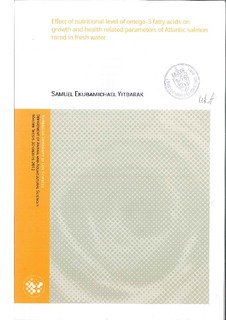| dc.description.abstract | Fish are the main supplier, in the human food basket, of the health beneficial n-3 highly unsaturated fatty acids (HUFA). Fish oil (FO) has traditionally been used as the dominating lipid component in fish feed. However, limited availability and fluctuation in price of this commodity force the aquaculture industry to use alternative vegetable oil (VO) sources, which reduced the n-3 HUFA level in the fillet of farmed fish.
One strategy to maintain a healthy omega-3 level in the fish fillet may be through selective breeding of fish with high levels of eicosapentaenoic acid (EPA) and docosahexaenoic acid (DHA). Another strategy may be to optimize the dietary ratio of fatty acids in order to facilitate the production of EPA and DHA from 18:3n-3 in the fish.
The n-3 HUFA level is a highly heritable trait in Atlantic salmon, genetic selection in combination with diet formulated has been proposed to improve n-3 HUFA content in farmed salmon. And further, genes involve in the HUFA biosynthesis pathway known to regulate by the fatty acid content of the diet.
The aim of this thesis was to study if offsprings of fish selected for high and low desaturase capacities have differences in body EPA and DHA levels and differences in gene expression of lipid regulatory genes. The fish from the two desaturase families were followed at different life stages from start-feeding to 40g. When fed different dietary levels of VO
The two families of Atlantic salmon (Salmo salar) were fed diets where the FO was gradually replaced by rapeseed oil (RO) and FO (0%RO, 25%RO, 50%RO, 75%RO, and 100%RO). Samples of whole body and liver were taken at different life-stages from start-feeding until the fish reached a final weight of approximately 40g.
After 182 days of feeding trial when the fish was 40g, the fatty acid compositions of whole body lipid of the two families were clearly affected by the fatty acid compositions of the diets. The high desaturase family had higher EPA and DHA levels in whole body of fish fed the 25%RO, 50%RO and 75%RO inclusion levels, than the low desaturase family.The gene expression of the Δ6b desaturase in whole body and expression of Δ6 desaturase(Δ6a, Δ6b, Δ6c), Δ5desaturases, elongases(Elovel_2) and ACO in the liver of fish fed different inclusion of RO, showed variation in expression in response to the different inclusion levels of RO fed groups and sampling periods. This variation in expression levels between the two families together with the higher EPA and DHA level in the high desaturase family at final sampling shows the potential of increasing these fatty acids in farmed fish via genetic selection. | no_NO |
